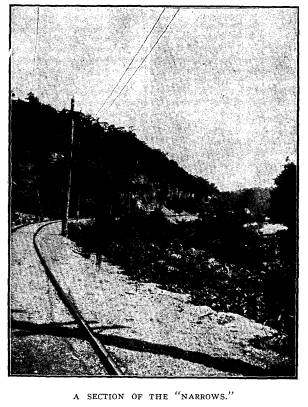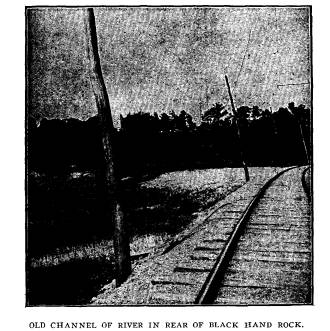Ohio History Journal
The Black Hand. 449
doubtless be a matter of regret to
everyone that the railroad
has recently changed the name of the
station, and the brakeman
no longer calls out Black Hand, but
Toboso. It is to be hoped
that commercial as well as historic
interest will induce the new
electric line to perpetuate the name of
Black Hand.
In a beautiful introduction to her
legend, among other
things, Mrs. Gebhart says: "The
Indian legend pertaining to this
relic of a prehistoric race was told me
by Colonel Robert David-
son, who settled in Newark in 1808.
There were many Indians
there at that time, and from them he
doubtless heard it. They
lingered long in the vicinity. I
remember being carried in his
arms, probably about 1835, to see the
party who had erected
their wigwams and camped in the public
square at Newark. I
remember with especial distinctness, one
squaw who carried a
papoose, Indian fashion, on her
back. Its black bead-like
eyes seemed to view me as curiously as I
on my part viewed it
from that coign of vantage a father's
protecting arm."
Hon. Alfred Kelly was one of the canal
commissioners under
whose supervision the canals of Ohio
were made. He probably
heard the legend while engaged in this
work. His rendering
has never been published. A manuscript
copy is in the pos-
session of his daughter, Mrs. Francis
Collins, of Columbus, who
has kindly consented to its publication
here.
THE BLACK HAND.
R. E. CHAMBERS, M. D.
Some time during the fifties, articles
appeared from time to
time under the nom-de-plume of
"Black Hand." These were
devoted to a history of the "boys
and girls of 1826." They were
pleasing and readable, and were very
lavish in extolling the at-
tractive traits of character that
adorned the developing woman-
hood and manhood of that period.
At the conclusion of his article he asks
the question, "Who
put that hand on the rock ?" or who
painted the hand on the rock?
- for it had the appearance of having
been painted.
Vol. XIII-29.
|
450 Ohio Arch. and Hist. Society Publications.
This rock is near the station on the B. & O. railroad which bears the name, "Black Hand." It is on the canal bank on the borders of Muskingum county and Licking county and was a place of much note as a pleasure resort in my boyhood days. It was a large rock with a face some eight feet high with a pro- |
|
|
|
jecting rock of some feet out and even over the canal. This hand was perfect and Mr. Sheward, who had taken much pains to see if he could find its origin, traced its history back to 1816, and the first traveler found this hand on the rock. The Indians did not use the open hand as an insignia to convey or perpetuate events, hence they could not account for the hand. |
The Black Hand. 451
To give what I thought was the best
solution to a question
of so much interest, I was disposed to
use the find of David Wy-
rick and a friend, who had taken
advantage of a removal of a
large mound for the stone and dirt it
contained by the B. & 0.
railroad, a work of our prehistoric
citizens of a time we know
not of. David Wyrick and his friend, who
had been deeply inter-
ested in this mound in the years past,
and as to what it might con-
tain, determined to explore to a greater
depth than the removal
of the accumulations by the railroad.
They were not long in striking a rock in
their descent and
finding it was single and elongated
continued their work until
they uncovered it. They found the top
was of the character of a
slab, which on removal revealed the
skeleton of what was once
a human being. While decomposition had
been perfect, the mould
of the covering over the remains gave
evidence of fibers as if
the body had been clothed with a woolen
garment. They re-
moved the stone coffin and found beneath
it a stone of a foot
and a half in length, that gave evidence
of having been sharpened
and upon handling it they found that it
contained something
in its interior. They, with some
trouble, opened it, finding in-
side a stone twelve inches long and four
inches wide and an inch
in thickness. It had a neck broken off,
in the end was a hole. This
gave evidence of having been worn as if
a strap had been inserted
and it was carried in this way.
They were much astonished to find
engraved on one side an
outline or profile of a man in the dress
of a Hebrew and on the
other side characters which they could
not make anything out
of. Living in Newark, and having
knowledge of the Episcopal
minister as a man of fine education,
they went with it to him,
and he took the stone and was greatly
astonished to find that the
characters were Hebrew. He said he would
see if he could read
or decipher it. He did so. Calling to
his aid his Hebrew works,
he was able to translate nine
commandments, one was left off.
Fearing that his translation was not
correct, and having
a knowledge of Rev. Matthew Miller, of
Monroe township, this
county, who was at that time at his home
from New York, where
he had been laboring in his efforts to
convert the Jews, and
|
452 Ohio Arch. and Hist. Society Publications.
knowing that he was greatly distinguished as a Hebrew scholar, he wrote to him of the find, asking his assistance. His deep interest in that people caused his immediate trip to Newark. One of the letters or characters was not closed at the top, and for fear that he should be mistaken in view of this character, he went to Cincinnati to a Hebrew rabbi, and pre- sented to him the tablet. His translation was the same as that of the two other ministers. His attention being called to this var- |
|
|
|
iation in the letter, he said: "This is ancient Hebrew that you know nothing about." Rev. Matthew Miller said to me that the dating on this tablet ante-dated the birth of Christ eight thousand years. This hand pointed to the mound that contained the last rabbi who ministered at the altar. Doubtless when his work was done his followers gave a burial that went to show their love and esteem, in the mound they raised over his remains and the |
The Black Hand. 453
tablet, that was as a guide to their
faith, and then put the hand
on the rock, pointing to the place of
his burial.
THE MINGO CAPTIVE AND THE WYANDOT MAIDEN
AND
THE NEUTRAL GROUND.
H. C. COCHRAN.
An Indian sat at the door of a settler's
cabin and told this
story: Many years ago the red men in the
eastern part of the
state were at war with those in the
middle and northwestern part.
Chief among the former were the Mingos,
and among the latter,
the Wyandots. In one of the stealthy and
bloody incursions
into the Mingo hunting grounds, a young
chief of great promise
was captured and carried back by the
Wyandots. Instead of kill-
ing the young Mingo chieftain, as was
the usual custom, he was
made a serf and compelled to earn the
good-esteem and fellow-
ship of his captors, a fate worse than
death to the young Indian.
The woes of his captivity, however, were
lightened by the kindly
attention of a young Wyandot maiden, the
daughter of the chief
of the tribe into which the Mingo had
been adopted. Genuine af-
fection knows no condition, or it rises
above all environment. The
maiden fell in love with the unfortnate
young chief, and though
watched by the crafty tribesmen, they
made their affection known
to each other and decided to fly to the
Mingo country. One
night they made their escape. At
daylight they were missed
and were pursued by a posse of Wyandots.
The girl had left
behind a tribesman lover, who burning
with the passion of a
disappointed lover, and aching for
vengeance traveled faster
than the couple and overtook them at
Black Hand rock. They
heard the pursuers behind them, knowing
that worse than death
awaited them if captured. With the
stoicism of the savage, they
walked to the edge of the precipice and
surveyed the flood. Fold-
ing the idol of his heart in his arms,
he sprang into the boiling
waters. The pursuers were close enough
to see the last chapter
of the drama. The narrator says the
disappointed pursuers
marked the spot as the Caucasian found
it.
The other legend, one worthy of
perpetuity, is born of the
geology of the country and the trade
conditions of the aboriginees.

